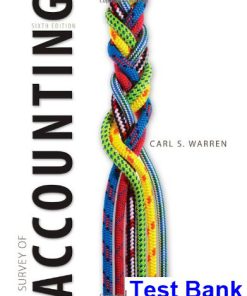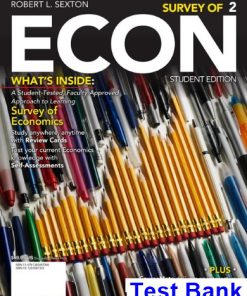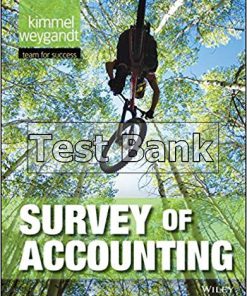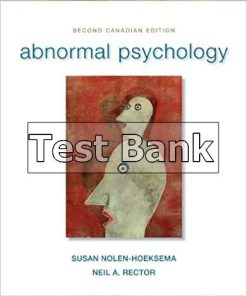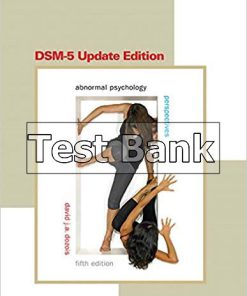Survey of ECON 3rd Edition Sexton Test Bank
You may also like
-
$26.50
$50.00 -
$26.50
$50.00
Survey of ECON 3rd Edition Sexton Test Bank

Product details:
- ISBN-10 : 1305657616
- ISBN-13 : 978-1305657618
- Author: Robert Sexton
Learn Economics YOUR Way with Survey of ECON 3! Survey of ECON 3’s easy-reference, paperback textbook presents course content through visually-engaging chapters as well as Chapter Review Cards that consolidate the best review material into a ready-made study tool. With the textbook or on its own, Survey of ECON 3 Online allows easy exploration of Survey of ECON 3 anywhere, anytime – including on your device! Collect your notes and create StudyBits� from interactive content as you go to remember what’s important. Then, either use preset study resources, or personalize the product through easy-to-use tags and filters to prioritize your study time. Make and review flashcards, review related content, and track your progress with Concept Tracker, all in one place and at an affordable price!
Table contents:
Part I Regional economics 1
1 Regional income and employment determination 5
1.1 Impact analysis: indirect and induced effects 7
1.2 The Keynesian income–expenditure approach 8
1.3 Applications of regional multiplier analysis 15
1.4 Weaknesses of regional multiplier analysis 20
1.5 A multi-region model of income determination 21
1.6 Further developments in the economic modelling of regions 27
1.7 Regional econometric models 30
1.8 Conclusion 33
Further reading 34
2 The input–output approach to modelling the regional economy 35
2.1 The input–output method 37
2.2 Regional applications of input–output analysis 49
2.3 Some limitations of the input–output approach 56
2.4 New developments in regional modelling 58
2.5 Conclusion 62
Further reading 63
3 Regional growth disparities: neoclassical perspectives 64
3.1 Regional growth disparities: some facts 66
3.2 The neoclassical growth model 66
3.3 Identifying the components of economic growth in practice 72
3.4 Endogenous technological progress: the engine of growth 76
3.5 Technology transfer between regions: catching up with the technology leaders 79
3.6 The convergence of regional per capita incomes in practice 81
3.7 Extending the neoclassical growth model 85
3.8 Conclusion 88
Further reading 89
4 Export demand models, agglomeration and cumulative growth processes 90
4.1 The demand for a region’s output: the export-base approach 91
4.2 Regional exports and cumulative causation: a model of regional growth 94
4.3 A constraint on regional growth: the balance of payments 101
4.4 Some alternative explanations of cumulative growth 104
4.5 Trade costs, industrial clusters and regional growth 107
4.6 Evidence of the economic benefits of industrial agglomeration 109
4.7 The spatial concentration of the financial sector in core regions 111
4.8 Empirical studies of cumulative growth processes 113
4.9 Conclusion 117
Further reading 118
5 Interregional trade 119
5.1 The basis of regional trade specialization 122
5.2 More modern theories of regional trade 131
5.3 Conclusion 138
Further reading 139
6 Interregional migration 140
6.1 The classical theory of labour migration 141
6.2 Interregional migration in Great Britain, 1961–96 143
6.3 The determinants of migration: relaxing the assumptions of the classical model 147
6.4 Alternatives to the classical theory of migration 153
6.5 Migration during periods of recession 158
6.6 The effects of migration: Is migration equilibrating? 162
6.7 Conclusion 164
Further reading 165
7 Regional unemployment disparities 166
7.1 Regional unemployment disparities: Why do they persist? 168
7.2 The causes of unemployment: the conventional approach 175
7.3 Estimating the relative importance of the various types of unemployment 179
7.4 Empirical studies of regional disparities in unemployment 184
7.5 Socio-demographic causes of unemployment: evidence from the UK 192
7.6 Hidden unemployment 195
7.7 Conclusion 200
Further reading 201
Part II Regional policy 203
8 The case for regional policy: British experience 205
8.1 The case for reducing regional economic disparities 206
8.2 Policy action: alternative approaches 209
8.3 The historical development of regional policy in Britain 214
8.4 Regional policy: economic efficiency or social inclusion? 225
8.5 Conclusion 230
Further reading 231
9 Regional policy instruments 232
9.1 Micro-policy instruments and regional policy 234
9.2 Controls on businesses: location controls or pro-business measures? 239
9.3 Capital subsidies versus labour subsidies 241
9.4 Community economic development initiatives 254
9.5 Conclusion 261
Further reading 262
10 Indigenous development: small and medium enterprises and technological progress 263
10.1 Regional policy and the SME sector 264
10.2 Regional policy and new technology 286
10.3 Industrial districts, innovative milieux and ‘learning regions’ 292
10.4 Conclusion 300
Further reading 302
11 Regional policy and the European Union 303
11.1 Regional problems in the European Union 304
11.2 Regional policy in the European Union 319
11.3 Existing EU regional policy 324
11.4 Conclusion 334
Further reading 335
12 Regional policy and devolution 336
12.1 The changing system of regional governance 337
12.2 The regional implications of centralized control 341
12.3 Partial devolution: allocating fiscal policy powers to regional authorities 352
12.4 The complete devolution of fiscal, monetary and trade policy powers 359
12.5 Conclusion 360
Further reading 361
13 The evaluation of regional policy 362
13.1 The evaluation process 364
13.2 Aggregate studies of the effect of regional policy on employment trends in the assisted areas 368
13.3 Estimating the effect of regional policy on inward investment into the assisted areas 370
13.4 Regional policy and foreign inward investment 374
13.5 Surveys of assisted firms 383
13.6 Ex ante evaluation of regional incentives using the cost–benefit approach 388
13.7 Using large-scale regional models to estimate policy impacts 393
13.8 Evaluation of regional development programmes: the EU’s Structural Funds 396
13.9 Conclusion 400
Further reading 401
References and bibliography 402
Index 429
People also search:
survey of economics
survey of economics class
survey of economics pdf
|
survey of economic projections
a survey of professional economists revealed
|


